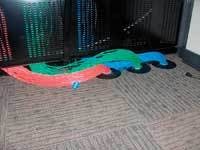by Donna Ballast
Cabling’s transition from the building pathway into the system furniture pathway is a critical but often overlooked detail in cabling projects. For example, the United States Marine Corps hired a project manager to provide, and I quote, “aggressive quality assurance advocacy for the communication and information systems” being installed in their new command operations facility building.
That’s a good idea, but it sounds like they arrived at it a little late in the design/build process. The project manager sent me an e-mail describing the situation and attached these photos.
Acting as a commissioning agent, he has already exhausted his list of requirements from the project specifications, and had hoped some National Electrical Code requirement would “cover” this issue. And, of course, there are none. He is understandably frustrated.
I believe it was Frank Lloyd Wright who commented that doctors can bury their mistakes, but architects can only advise their clients to plant shrubbery. Well, as telecommunications systems designers, it may be time to bring in the potted plants on this one.
Practically speaking, for the first situation, the floor tiles could be carefully cut and the transition from underfloor-to-furniture relocated under the furniture-system wall panel.
As for the second situation-and yes, this only addresses aesthetics and not cable support or abrasion protection-covering the exposed cables with a split, flexible, non-metallic tubing in gray or black is about as good as it gets. Unless, of course, you want to pull the cables back to the wall and reroute, reterminate, and retest.
My motto is, “When in doubt, spec it out,” borrowing where possible from the NEC requirements for branch circuits. For example, NEC 2005 Article 605 Office Furnishings (Consisting of Lighting Accessories and Wired Partitions) states: “All conductors and connections shall be contained within wiring channels of metal or other material identified as suitable for the conditions of use. Wiring channels shall be free of projections or other conditions that may damage conductor insulation.”
So, why not add the requirement for another “wiring channel” or two to your project specifications, separate from the channel containing the branch circuits for light and power, for the telecommunications cable? Have your “wiring channels” extend from the termination of the building pathway (wall or floor) to the work area outlet in the office partition.
Still worried about what the transition will look like? Require a shop drawing and/or a mockup be provided for your approval prior to installation of the cabling.
It sure beats watering all those plants.DONNA BALLAST is BICSI’s standards representative, and a BICSI registered communications distribution designer (RCDD). Send your question to Donna at: [email protected]


